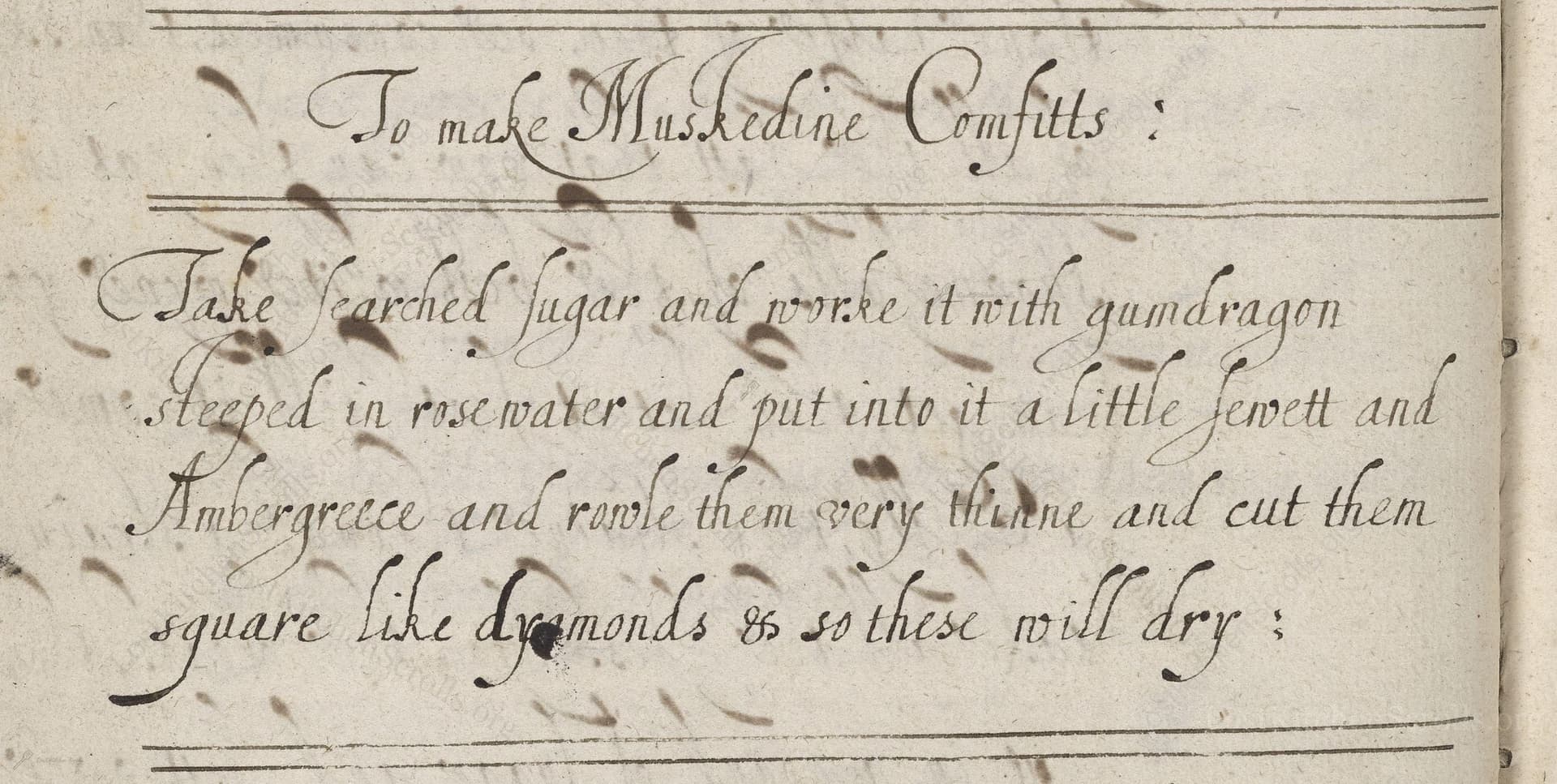To Make Muskedine Comfitts
From the treasured pages of Medicinal and cookery recipes by John King
Written by John King

To Make Muskedine Comfitts
"Take searched sugar and worke it with gumdragon steepd in rosewater and put into it a little sivett and Amber greece and rowle them very thinne and cut them square like dyamonds & so these will dry :"
Note on the Original Text
The recipe is written in the dense shorthand typical of early modern English recipe books, omitting quantities and assuming the reader’s familiarity with confectionery processes. Spelling variations such as 'sivett' (civet), 'Amber greece' (ambergris), and 'searched sugar' (sifted or sieved sugar) are standard for the era. Recipes of the time favored brevity, prioritizing the unique ingredients and the general technique over precision, as most would have been made by household cooks already these concepts.

Title
Medicinal and cookery recipes by John King (1675)
You can also click the book image above to peruse the original tome
Writer
John King
Era
1675
Publisher
Unknown
Background
A delightful journey into the kitchens of the 17th and early 18th centuries, this collection, attributed to John King, brims with time-honored recipes, culinary wisdom, and flavors that once graced historic tables.
Kindly made available by
Folger Shakespeare Library
This recipe, 'To make Muskedine Comfitts', hails from the collection of John King, dated between 1625 and 1725. At this time, English tables were often graced by comfits—tiny sugar-coated seeds or aromatic sugar pastilles considered both medicinal and luxurious. The use of rare scents such as musk, civet, and ambergris was a sign of extravagance, typical for the aristocratic tables during the late Stuart and early Georgian periods. Recipes like this straddle the boundary between sweetmeats and perfumery, reflecting a time when fragrant, precious ingredients conveyed status and refinement.

Historically, cooks would use a mortar and pestle to grind and sieve sugar to a fine powder, known as 'searched' sugar. Gumdragon (gum tragacanth) would be soaked in Rosewater in a small bowl or dish and then kneaded into the sugar paste by hand on a smooth stone or marble slab. A rolling pin (or a glass bottle) would be used for rolling out the aromatic sugar paste, and a paring knife or fine blade to cut the delicate diamonds. The comfits would dry on sheets of parchment or clean linen in a cool, dry pantry.
Prep Time
20 mins
Cook Time
0 mins
Servings
12
We've done our best to adapt this historical recipe for modern kitchens, but some details may still need refinement. We warmly welcome feedback from fellow cooks and culinary historians — your insights support the entire community!
Ingredients
- 7 oz caster sugar, sieved
- 1 teaspoon food-grade gum tragacanth ('gumdragon')
- 2 tablespoons (1 fl oz) rosewater
- 1 drop (or smallest possible amount) real civet extract or modern musk substitute*
- A tiny pinch (less than 1/8 teaspoon) of ground ambergris or synthetic substitute
- *Note: Real civet/musk and ambergris are rarely used today; vanilla or floral extracts can be substituted for a similar aromatic profile, but the historic result used animal-derived scents.
Instructions
- Begin by making your base: in a small bowl, dissolve 1 teaspoon of food-grade gum tragacanth (gumdragon) in 2 tablespoons (1 fl oz) of rosewater and let it soak until fully hydrated, about 2-3 hours or overnight for a smooth, paste-like consistency.
- Next, measure out 7 oz of fine caster sugar and sieve it to ensure it's very smooth.
- Blend the hydrated gum mixture into the sugar, kneading together to make a stiff, slightly sticky paste.
- Into this, add a drop (less than 1/8 teaspoon) of natural musk substitute or a drop of civet absolute if obtainable, plus a minuscule pinch (less than 1/8 teaspoon) of powdered ambergris substitute; mix thoroughly.
- Roll the mixture out on a sugared surface with a rolling pin until very thin — about 1/8 inch thickness.
- Cut the paste into diamond shapes using a knife or pastry cutter.
- Lay them out on wax paper or a silicon mat to dry at room temperature for 24-48 hours, until completely set and dry to the touch.
Estimated Calories
60 per serving
Cooking Estimates
You will spend most of your active time mixing and rolling the paste, as there is no actual cooking. The gum tragacanth needs to soak for a few hours or overnight, and the cut sweets need to dry for a day or two. Each piece is small and mostly sugar, so the calories per serving are moderate.
As noted above, we have made our best effort to translate and adapt this historical recipe for modern kitchens, taking into account ingredients nowadays, cooking techniques, measurements, and so on. However, historical recipes often contain assumptions that require interpretation.
We'd love for anyone to help improve these adaptations. Community contributions are highly welcome. If you have suggestions, corrections, or cooking tips based on your experience with this recipe, please share them below.
Join the Discussion
Rate This Recipe
Dietary Preference
Main Ingredients
Culinary Technique

Den Bockfisch In Einer Fleisch Suppen Zu Kochen
This recipe hails from a German manuscript cookbook compiled in 1696, a time whe...

Die Grieß Nudlen Zumachen
This recipe comes from a rather mysterious manuscript cookbook, penned anonymous...

Ein Boudain
This recipe comes from an anonymous German-language manuscript cookbook from 169...

Ein Gesaltzen Citroni
This recipe, dating from 1696, comes from an extensive anonymous German cookbook...
Browse our complete collection of time-honored recipes



